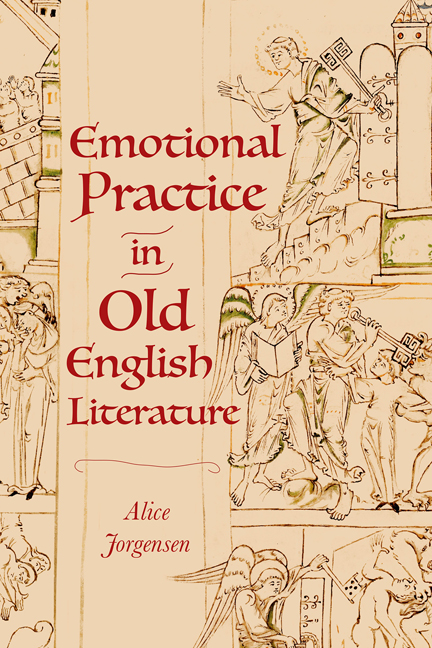Book contents
- Frontmatter
- Dedication
- Contents
- Acknowledgements
- Abbreviations
- Introduction: The Wanderer and Emotional Practice
- 1 Participating in a Heroic Emotional Style: Beowulf
- 2 Uses of the Heroic Style: The Battle of Brunanburh and The Battle of Maldon
- 3 Controlling and Converting Emotion: The Old English Boethius
- 4 Relating to the Divine in the Exeter Book: Christ I and Christ III
- 5 Performing Fear in Old English Homilies
- Conclusion
- Bibliography
- Index
- Miscellaneous Endmatter
1 - Participating in a Heroic Emotional Style: Beowulf
Published online by Cambridge University Press: 09 May 2024
- Frontmatter
- Dedication
- Contents
- Acknowledgements
- Abbreviations
- Introduction: The Wanderer and Emotional Practice
- 1 Participating in a Heroic Emotional Style: Beowulf
- 2 Uses of the Heroic Style: The Battle of Brunanburh and The Battle of Maldon
- 3 Controlling and Converting Emotion: The Old English Boethius
- 4 Relating to the Divine in the Exeter Book: Christ I and Christ III
- 5 Performing Fear in Old English Homilies
- Conclusion
- Bibliography
- Index
- Miscellaneous Endmatter
Summary
ON HIS return to Geatland, Beowulf reports to Hygelac on his experiences in Denmark, including the celebrations in Heorot after the defeat of Grendel.
Þǣr wæs gidd ond glēo; gomela Scilding,
felafricgende feorran rehte;
hwīlum hildedēor hearpan wynne,
gome(n)wudu grētte, hwīlum gyd āwræc
sōð ond sārlic, hwīlum syllic spell
rehte æfter rihte rūmheort cyning;
hwīlum eft ongan eldo gebunden,
gomel gūðwiga gioguðe cwīðan,
hildestrengo; hreðer (in)ne wēoll
þonne hē wintrum frōd worn gemunde.
Swā wē þǣr inne andlangne dæg
nīode nāman (Beowulf, 2105–17a)
There was song and entertainment; the old Scylding who knew many things recounted tales of long ago; sometimes the one brave in battle touched the joy of the harp, the wood of entertainment, sometimes told a true and sad tale, sometimes the generous-hearted king accurately recounted a wondrous story; sometimes again the old warrior, bound by age, began to lament his youth, his battle-strength; his breast surged within him when, old in winters, he recalled a multitude of things. Thus for the whole day we took our pleasure in there.
This richly suggestive passage raises various questions, including whether the terms gleo, gydd, spell and cwiðan refer to different genres and whether the ‘gomela Scilding’ is Hrothgar. For the purposes of the present study, however, its striking feature is the prominence of emotion terms, including the imagery of surging within the breast (the hydraulic model of emotion), in association with poetic performance. Antonina Harbus remarks on the description of tales as ‘soð and sarlic’, ‘as if the mournfulness were as essential as the truthfulness and both were inherently entertaining’:
The suggestion in Beowulf is that the public experience of sorrow, through shared memory and textualizing the past, is a social bond. This pervasive textualized sorrow might act as a model for the poem as a whole.
The ‘public experience of sorrow’ in the passage is not merely entertaining but involves joy and pleasure (wynn, niod). On the other hand, the sorrow is not confined to the text-world of the tales of old: Hrothgar expresses personal loss that produces a powerfully physical sadness. Story and experience, community and individual, verbal art and embodied emotion come together in this sequence, which is also, as Harbus highlights, one of Beowulf's many self-reflexive moments, with implications for how the poet conceived the functions and nature of heroic poetry.
- Type
- Chapter
- Information
- Emotional Practice in Old English Literature , pp. 29 - 69Publisher: Boydell & BrewerPrint publication year: 2024



